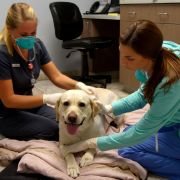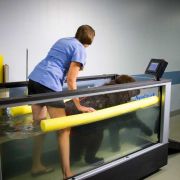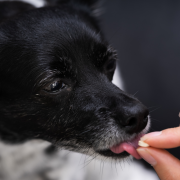Date:
By Alan Green and Arnaldo Torres
Most Lowcountry pet owners are aware that there are snakes in our woodlands, parks and possibly our own backyards. After the recent flooding, pet owners have reported an increased number of snake sightings; these reptiles can represent a threat to any curious pets that get too close to one. This month Dr. Arnaldo Torres, one of our esteemed emergency doctors, will present an overview of how snakebites affect pets and the treatment options that are available to unlucky victims.
Curious dogs and cats that choose to investigate snakes often find themselves with a rather nasty bite as a consequence. Lowcountry pets are affected by snakebites most commonly in the warm summer months, but we do see affected pets year-round. All venomous snakes in the area are pit vipers, a type of snake with a heat sensing pit organ located in their heads. Of the multiple species of pit vipers living in our area, we recognize that animals most often experience encounters with copperhead snakes, though bites from a rattlesnake commonly result in the most life threatening consequences. Interestingly, bites to extremities tend to result in less severe consequences than those to the head and face.
Composition of snake venom varies by species and age of the snake, season of the year, geographic location and time since the snake’s last bite. Pit viper venom kills body cells at the site of the bite and may cause destruction of red blood cells, abnormal bleeding, muscle weakness and shock in animals that have been bitten. Animals frequently exhibit oozing of bloody fluid from the puncture wounds, with varying degrees of associated pain and swelling. These signs are seen within 30 minutes after being bitten by a pit viper. Tissue damage, muscle destruction, respiratory failure or harm to other vital organs may be delayed for more than 24 hours.
Diagnosis of envenomation is made by observation of the bite, inspection of the characteristic wounds and presence of compatible clinical signs. No diagnostic tests are available to confirm the presence of venom in the body; rather, laboratory tests are used to assess damage to blood cells and other body systems. Interestingly, up to 25 percent of snakebites are termed dry bites (meaning that no venom was released during the bite.) These lucky pets understandably experience fewer complications as a result of their encounter.
Treatment of pit viper bites involves supportive care measures, which include intravenous fluids, pain medication and careful cleansing of the wound. During initial therapy, blood pressure, pulse quality, gum color, heart rate and rhythm, breathing rate, blood oxygen levels, neurologic status, body temperature and urine output are monitored on a continual basis. In the following days, laboratory tests and chest x-rays may be performed to detect problems that may arise in other organs as a result of envenomation. Frequently, these pets are monitored in a hospital for 24-48 hours and may return for further outpatient testing.
An antivenom effective against most snakes found in the area can be used to slow the progression of clinical signs. This treatment requires intensive monitoring in a hospital environment and is not without risk. Cottonmouth and copperhead bites less commonly require antivenom compared to bites from rattlesnakes. This treatment, however, may prove life saving to pets severely affected by pit viper envenomation.
Prior to hospitalization, there are no effective means to prevent the spread of venom from the bite site. Manipulation of the wound (including cutting and sucking on the wound or application of a tourniquet, ice, or heat to the area) is not recommended. Dogs who have been bitten are in extreme pain and may be in a state of shock. To complicate things further, the offending snake cannot always be identified. In these cases the veterinary team prepares for the worst and hopes for the best. If you suspect that your pet has been bitten by a snake, stay calm, handle them with care and seek veterinary attention immediately. Many dogs survive being bitten by a snake with early, appropriate therapy improving prognosis.


















